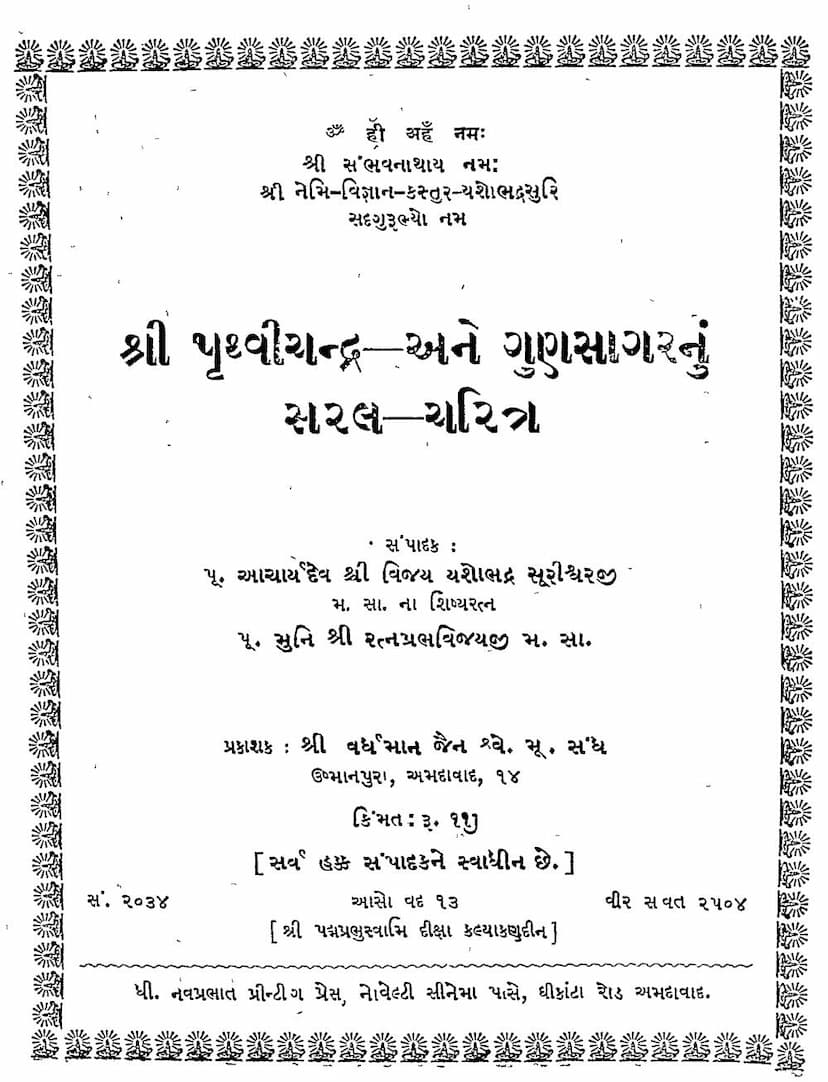Pruthvichandra Tatha Gunsagarnu Saral Charitra
Added to library: September 2, 2025

Summary
This Jain text, "Pruthvichandra tatha Gunsagarnu Saral Charitra" by Ratnaprabhvijay, chronicles the lives and spiritual journeys of Pṛthvīchandra and Guṇasāgara, who ultimately attain Kevalajñāna (omniscience) and Moksha (liberation) after a series of twenty-one lifetimes. The book is published by Vardhaman Jain Shwetambar Murtipujak Sangh.
Key Themes and Concepts:
- Kathānuga (Narrative Approach): The text employs a narrative style, using stories to convey profound Jain philosophical principles. This approach aims to make complex concepts accessible and relatable to the reader.
- Spiritual Evolution through Rebirths: The central theme revolves around the concept of rebirths (bhavas) and how actions in past lives (karma) shape present circumstances and spiritual progress. Pṛthvīchandra and Guṇasāgara's twenty-one lifetimes illustrate this journey, featuring various human and divine existences.
- The Goal of Liberation (Moksha): Like all Jain scriptures, the ultimate aim is to guide beings away from worldly attachments and towards spiritual purification, leading to liberation from the cycle of birth and death.
- The Power of Righteous Conduct: The narratives emphasize the importance of adherence to Jain principles like right faith (Samyaktva), right knowledge, and right conduct (Samyama), highlighting how these practices lead to spiritual upliftment and eventual liberation.
- The Nature of Relationships: The text explores how relationships evolve across lifetimes, with individuals appearing in various roles such as husband-wife, friends, father-son, and even enemies, all governed by the principle of ṛṇānubandha (karma-induced bonds).
- Understanding Desire and Its Consequences: The stories sometimes feature characters driven by desire, illustrating the detrimental outcomes of such attachments and the resulting downfall.
- The Role of Sins and Virtues: The book implicitly and explicitly contrasts the consequences of negative actions (sins) and positive actions (virtues), showing how the latter pave the way for spiritual progress.
- The Importance of Wisdom and Detachment: The narratives showcase characters who cultivate wisdom and detachment from worldly pleasures, recognizing the ephemeral nature of existence and striving for eternal bliss.
Narrative Highlights:
- The Journey Begins: The story often traces its protagonists back to their initial lives, showing the seeds of their eventual spiritual attainment being sown.
- Intertwined Destinies: Pṛthvīchandra and Guṇasāgara's lives are consistently linked, highlighting their spiritual companionship and mutual support throughout their numerous rebirths.
- Illustrative Examples: The text uses vivid descriptions and detailed accounts of their experiences, both joyous and sorrowful, to illustrate the teachings. For instance, it clarifies that sometimes the depiction of sensuous characters is not to glorify sensual pleasure but to demonstrate its ultimately negative consequences.
- The Path to Kevalajñāna: The narratives detail the gradual purification of the soul, the shedding of karmas, and the progressive development of spiritual knowledge, culminating in the attainment of Kevalajñāna.
Overall Message:
The "Pruthvichandra tatha Gunsagarnu Saral Charitra" serves as an inspirational guide, using engaging stories to underscore the Jain path to liberation. It emphasizes the transformative power of righteous living, detachment from worldly pursuits, and the unwavering pursuit of spiritual knowledge across lifetimes, ultimately leading to the highest state of being. The book reinforces the belief that through persistent effort and adherence to Dharma, even the most complex karmic entanglements can be overcome to achieve eternal peace and bliss.